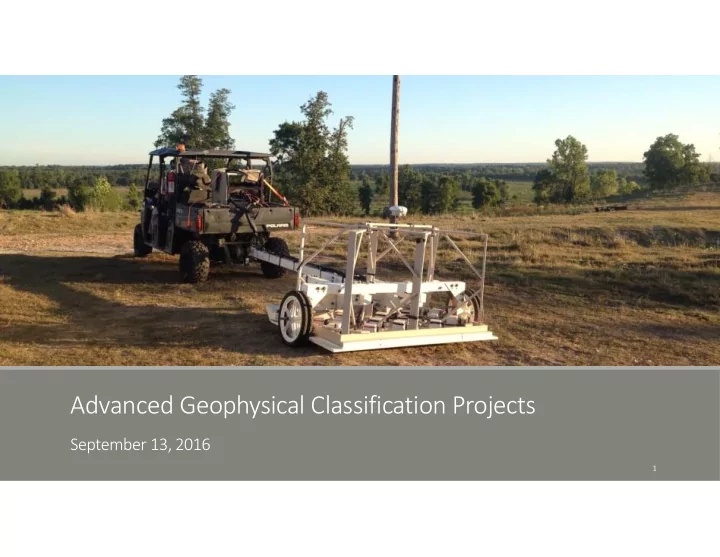

Advanced Geophysical Classification Projects September 13, 2016 1
Advanced Geophysical Classification • Advanced EMI sensors utilize multiple transmitter and receiver coils to acquire data from numerous angles and positions • Rich dataset can be inverted to extract intrinsic features of anomaly sources • Intrinsic features of anomaly sources (such as mass, shape, and wall thickness) are not influenced by burial depth or orientation • Intrinsic features (polarizability curves) can be compared to a library of known signatures to classify the anomaly sources as targets of interest (TOI) or non ‐ TOI prior to intrusive investigation • Result: The ability to identify subsurface anomaly sources that have a low likelihood of being MEC and can therefore be safely left in the ground • Current technologies require a two ‐ step survey process: • Dynamic detection survey to identify subsurface anomalies • Cued (static) data acquisition to acquire the robust data required for classification • AGC is not always the best option, but it is another tool in the toolbox 2
Unit 23 Risk Reduction • Risk reduction activity objective: • To reduce the risk identified by USACE Safety to prescribed burn personnel due to potential existence of 155mm projectiles (or larger MEC items) in the shallow subsurface • Detected anomalies meeting the amplitude response characteristics of 155mm projectile (or larger MEC items) will be investigated with cued MetalMapper survey • Down to 2 feet in the outer region to protect burn personnel around perimeter • Down to 1 foot in the inner region to protect burn personnel in helicopters above the burn • High ‐ confidence non ‐ TOI anomalies will be left in the ground • Anticipate cued MetalMapper investigation of approximately 3,500 anomalies • Anticipate subsurface removal of approximately 500 TOI 3
Unit 23 Risk Reduction 4
Broadway Bypass Subsurface MEC Removal • Fuel break subsurface MEC remediation of Broadway Bypass • Rerouting of fuel break crosses area of high density subsurface anomalies (based on EM61 survey) • AGC processes will be used to conduct MEC removal to depth • Dynamic MetalMapper detection DGM • Detect subsurface anomalies potentially related to MEC • Static MetalMapper classification DGM • Classify detected anomalies as either TOI or non ‐ TOI • Intrusively investigate and remove TOI 5
Broadway Bypass Subsurface MEC Removal 6
Munitions with Sensitive Fuzes Field Study • Field Study Objective: • Determine the most cost ‐ effective MEC detection and remediation method for areas with high anomaly density and evidence of MEC with sensitive fuzes • 11 ‐ acre field study area • Within Range 48, where a variety of MEC types were previously removed, including small munitions with sensitive fuzes • Wide range of anomaly densities (but all high) • Two DGM systems • Demonstrate OPTEMA dynamic detection/classification survey • Compare to standard EM61 detection survey • Intrusive investigation of 3,000 targets (both EM61 and OPTEMA) 7
Munitions with Sensitive Fuzes Field Study 8
Recommend
More recommend